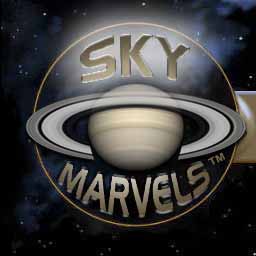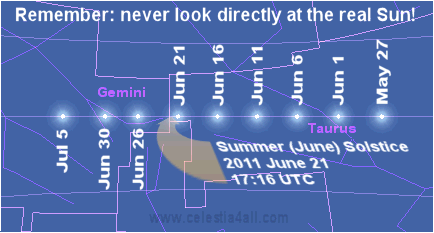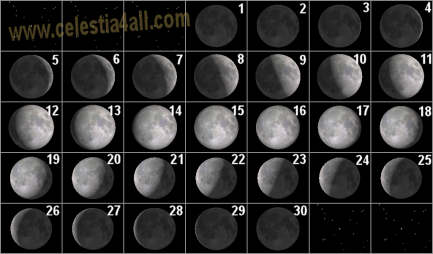








AVAILABLE MONTHS
2010:
Jan
Feb
Mar
Apr
May
Jun
Jul
Aug
Sep
Oct
Nov
Dec
2011:
Jan
Feb
Mar
Apr
May
Jun
CELESTIA 1.6.1 NOW AVAILABLE
Are you that type of person who always has to have the "latest and greatest"? Good news! The latest version of CELESTIA (ver. 1.6.1) is now available! And remember, this astro-simulation marvel is free!
We'll be putting version 1.6.1 through its paces and, in next month's News page, we'll report what we find. In the meantime, enthusiasts who just can't stand to wait can download CELESTIA 1.6.1 here.
![]() 1.6.x & 1.4.1 LINKS
1.6.x & 1.4.1 LINKS
Throughout this website you will find pairs of links labeled "1.6.x" and "1.4.1". Click here for a brief explanation.
UTC: CELESTIA'S DISPLAY OF TIME
CELESTIA's clock displays Coordinated Universal Time, UTC. Click here for a brief explanation.
APPARENT PATHS OF THE PLANETS
The eastern skies just before sunrise again put on a show in early June, as Mercury, Venus and Mars "follow" the Sun into Taurus. Jupiter lags behind in Aries, as it and the more distant planets move little.
Note: in the 1.6.x and 1.4.1 links in this column below, planets east ("left") of the Sun are visible in your sky after sunset, while planets west ("right") of the Sun are visible before sunrise.

MERCURY: 2011 Jun
In its journey behind the Sun this month, Mercury moves through Taurus and Gemini, barely making it into Cancer at June's end (1.6.x) (1.4.1)
VENUS & MARS: 2011 Jun
Venus and Mars begin June in eastern Aries. Then, as it distances itself from Mars, Venus moves into Taurus and traverses most of it by month's end (1.6.x) (1.4.1)
JUPITER: 2011 Jun
Slower moving Jupiter, lags behind the Sun and the Inner Planets in June, starting the month in Pices and then entering Aries (1.6.x) (1.4.1)
SATURN: 2011 Jun
Slow-moving Saturn remains in Virgo for the whole month, starting June in retrograde motion then stopping and reversing near mid-month (1.6.x) (1.4.1)
URANUS: 2011 Jun
Lagging behind in eastern Pisces, slow-moving Uranus remains west of the 4-planet "gathering" noted above (1.6.x) (1.4.1)
NEPTUNE: 2011 Jun
Slow-moving Neptune lingers in Aquarius, as the other planets leave the blue gas giant behind (1.6.x) (1.4.1)
CELES-TIPS
The following will help you enjoy this page's many links that run events directly in CELESTIA. If you're new to the program, these tips will also help you learn to use it.
- If CELESTIA's clock (i.e. the program's date and time) is not visible at the top right of its window, press the V key until you see it. This will also turn on information text in other corners as well. This text will help you keep track of several aspects of the event you're viewing.
- Pressing the "un-shifted" L key and K key respectively will speed up and slow down CELESTIA's flow of time by a factor of 10 in version 1.6.x and 1.4.1.
- Pressing Shift+L and Shift+K respectively will speed up and slow down CELESTIA's flow of time by a factor of 2 in version 1.6.x only.
- Pressing the J key (either shifted or "un-shifted") will reverse CELESTIA's flow of time in version 1.6.x and 1.4.1.
You'll find more information about many of CELESTIA's controls on our Learning Center page.
HIGHLIGHT EVENT
LUNAR ECLIPSE 2011 June 15
To view this video in a larger size, click here.
THE SUN
APPARENT PATH OF THE SUN: 2011 Jun
Here are the Sun's positions along the Ecliptic at 00:00 UTC on the days shown.

The slightly curved lines above and below the Ecliptic show the extent of the Zodiac, which you may download from our Bonuses page and add to any version of CELESTIA. Note that the curve in the Zodiac lines is the result of CELESTIA's rendering in perspective.
 W A R N I N G ! It is never safe to look directly at the real Sun with the naked eye! Moreover, looking at it through a telescope or binoculars—even for an instant—can cause permanent blindness! NEVER DO IT! Consult the professionals at your local planetarium or observatory to learn how you can safely "observe" the Sun and any SOLAR eclipse!
W A R N I N G ! It is never safe to look directly at the real Sun with the naked eye! Moreover, looking at it through a telescope or binoculars—even for an instant—can cause permanent blindness! NEVER DO IT! Consult the professionals at your local planetarium or observatory to learn how you can safely "observe" the Sun and any SOLAR eclipse!
Of course, you can safely view CELESTIA's depiction of the Sun's apparent path in the sky in June. Here are the links: (1.6.x) (1.4.1). Note that versions 1.6.x and 1.4.1 differ in the way their "follow" and "lock" features work. If you "follow" Earth and then "lock" the Sun to it, versions 1.6.x and 1.4.1 respectively maintain the "attitudes" of the Ecliptic and the the Celestial Equator. This means that the Ecliptic remains "level" when you run the first link, but begins to tilt when you run the second! Differences like this will be discussed on our Help page.
SUMMER (JUNE) SOLSTICE: 2011
Don't forget that you can use the 1.6.x /1.4.1 link above to view the Summer Solstice, when the Sun moves through its northernmost point in the sky for the year. Speaking astronomically, this marks the beginning of Summer and occurs when the Sun is about leave Taurus and enter Gemini. This year's Summer Solstice occurs at 17:16 UT on June 21.
CLIMATIC VS. ASTRONOMICAL SEASONS
Most school children know that the climatic seasons of the two hemispheres are the reverse of each other's. For example, when it is Summer in the Northern Hemisphere, it is Winter in the Southern Hemisphere, etc.
Of course, traditionally the "astronomical" seasons are named for the "climatic" ones of the Northern Hemisphere, which unfortunately creates an ambiguity. For example, for Southern Hemisphere astronomers, the Summer Solstice occurs during their climatic Winter!
This is why we increasingly see the less traditional (and slightly less recognizable) terms: "March" Equinox, "June" Solstice, "September" Equinox and "December" Solstice.
HALF OF EARTH IN SUNLIGHT & DARKNESS
During your voyages in CELESTIA, would you like to be able to position yourself directly over the center of the half of Earth in sunlight or the half in darkness at any time this month? On our Tips page, you'll find that it's quite easy to do so! If you're any kind of sky watcher at all, you probably know just how helpful this can be!
THE MOON
PHASES OF THE MOON: 2011 Jun
In UTC per CELESTIA 1.6.x:
New: Jun 1, 21:03. 1st Qtr: Jun 9, 02:11.
Full: Jun 15, 20:14. Last Qtr: Jun 23, 11:48.
(Celestia 1.4.1 usually indicates respective phase times within about one minute of those in version 1.6.x.)
NOTE: New, 1st Quarter, Full and Last Quarter Moons respectively are defined to occur when the Geocentric Ecliptic Longitudes of the Moon and the Sun differ by 0°, 90°, 180° and 270°.
To watch a short video demonstrating the Phases of the Moon, click here.

The above diagram is produced with our "Moon Phases Calendar" script. The numbers of the days of the month were added with an image-editing program.
To watch a short video of our Moon Phases Calendar in action, click here.
LUNAR APOGEE & PERIGEE: 2011 Jun
Per CELESTIA 1.6.x:
Perigee: Jun 12, 1:39 UTC; 367,185 km.
Apogee: Jun 24, 4:14 UTC; 404,282 km.
(Celestia 1.4.1 usually indicates apogee and perigee times within about one minute of those in version 1.6.x. Both versions of Celestia almost always indicate equal apogee distances and equal perigee distances.)
Determined by our "Earth-Moon Distance" and "Moon's Apparent Path" scripts. Note that distances given are those between Earth's and the Moon's centers.
Donate safely with: PayPal
to receive one or more
Sky-Gifts. Your support is greatly appreciated!
Various astronomical "shadow events" occur throughout the Solar System! This month's more interesting ones are featured here.
SHADOW WORKS
PARTIAL SOLAR ECLIPSE: 2011 Jun 1
This eclipse begins roughly over Japan at 19:25 UT and will be visible in eastern Asia, northern Alaska and Canada, Greenland and Iceland. The time of Greatest Eclipse, which occurs over northern Russia, is 21:16 UT.
NASA's Eclipse Information and Visibility Map
You can view an animation of this eclipse in our Solar Eclipses thru 2012 video

Here we highlight the most awe-inspiring eclipses taking place in our Solar System. We also set them up so that all you need to do is click on their links. Don't forget that you can generate lists of Earth's, Jupiter's, Saturn's, Uranus's, Neptune's and even Pluto's eclipses, using CELESTIA's own built-in "Eclipse Finder." You'll find it in the program's menu under "Navigation".
Unless noted otherwise, the events identified below are displayed as if viewed from Earth, their magnifications shown in parentheses at the lower right of CELESTIA's window. Events involving more than one moon are oftentimes cyclical, and the month's first occurence in a cycle is given. Look at the list of the moons' periods to get a good idea of when a cycle may repeat that month.
Remember: you can press the M key to toggle Moon Labels on and off, and press the , and . (comma and period) keys respectively to zoom in and out.
 JUPITER
JUPITER
Jupiter is now in that part of its orbit where its equatorial plane, and the orbital planes of the four Galilean moons, are increasingly tilting with respect to the Sun. While Io, Europa and Ganymede all produce solar eclipses each time they orbit Jupiter, this is not true of Callisto, whose increasingly tilting orbit has made it incapable of casting its shadow on Jupiter since last December. It will not be able to cast its shadow on Jupiter again until 2013!
Several simultaneous solar eclipses (i.e. involving more than one major moon) occur on Jupiter this month, most produced by Io and Europa. Here are highlights of the 30 solar eclipses that Io, Europa and Ganymede spawn in June, as Jupiter's shadow now extends to the planet's west (right).
With the Galilean info below, it is easy to see why some events involving more than one moon repeat. This info also lets you predict when events may recur.
Periods:
Io: 1.769 days
Europa: 3.551 days
Ganymede: 7.155 days
Callisto: 16.69 days
Resonances:
Io & Europa: 2 to 1
Io & Ganymede: 4 to 1
Europa & Ganymede: 2 to 1
- Jun 1: Io and Europa cast their shadows on Jupiter at the same time (as they will do about every 3½days until near month's end), and later pass Callisto (1.6.x) (1.4.1)
- Jun 3: Ganymede and Io cast their shadows on Jupiter at the same time, as Europa enters Jupiter's shadow (1.6.x) (1.4.1)
- Jun 6: Europa and Ganymede enter Jupiter's shadow as Io casts its shadow on Jupiter; this recurs in about 7 days (1.6.x) (1.4.1)
- Jun 10: all four Galileans are visible near Jupiter; Io casts its shadow as Europa disappears in Jupiter's; then Ganymede too casts shadow before Io finishes (1.6.x) (1.4.1)
- Jun 19: and Europa cast their shadows as Callisto moves "over" Jupiter (1.6.x) (1.4.1)
- Jun 27-28: as Io moves toward Jupiter from the east and prepares to cast its shadow, the other 3 Galileans are to Jupiter's west (1.6.x) (1.4.1)
 SATURN
SATURN
Like Jupiter, Saturn is now in that part of its orbit where its equatorial plane, as well as the orbital planes of its major equatorial moons, are all tilting more and more relative to the Sun. So fewer and shorter eclipses will occur on the ringed planet for some time. Rhea, Titan and Iapetus have not been able to cast shadows on Saturn since Oct 2010, Feb 2010 and Jun 2007 respectively. They will not cast their shadows on Saturn again until Mar 2024, Oct 2024 and July 2022 respectively. In addition, last month Dione cast its last shadow on Saturn until Jul 2023.
While CELESTIA 1.6.x shows the shadows of Titan, Rhea, Iapetus, Dione and Tethys, version 1.4.1 displays only the shadows of Titan, Rhea & Iapetus. So, 1.6.x and 1.4.1 respectively show 16 and no solar eclipses on Saturn in June. In addition, version 1.6.x reveals no double simultaneous solar eclipses this month, as only Tethys produces a solar eclipse on Saturn now for a dozen years! Moreover, Tethys is casting its shadow further and further south, and before long it too will not be able to produce a solar eclipse on Saturn for some time.
To aid in your viewing, here are the periods of Saturn's major moons. These do not exhibit the resonances that Jupiter's Galileans display. Still, you can use this info to predict subsequent eclipses of a single moon.
Tethys: 1.888 days
Dione: 2.737 days
Rhea: 4.518 days
Titan: 15.95 days
Iapetus: 79.33 days
- Jun 1: Tethys casts its shadow on Saturn, as it now does about every 2 days (1.6.x only)
URANUS, NEPTUNE & Dwarf Planet PLUTO
Neither Uranus nor Neptune will experience eclipses for decades. Dwarf planet Pluto will experience no eclipses by Charon for about a century!
Back to Top
Home Intro News Gallery Sky-Gifts Bonuses Tips
Learning Ctr Help Links Credits Legal Contact Us
© 2007-
by Gary M. Winter. All rights reserved.
Interested in political cartoons and humor?
Check out The HIPPLOMATS™.
SkyMarvels, SkyMarvels: Your Key to the Sky and the Universe! Sky Marvels, SkyMarvels.com, News, celestia4all, celestiaforall, CELESTIA, astronomy, space, simulations, animations, downloadable astronomy posters, stars, planets, Inner Planets, Outer Planets, Inferior Planets, Superior Planets, moons, asteroids, comets, Oort Cloud, galaxy, galaxies, Milky Way, Andromeda, globular clusters, binaries, quasars, black holes, supermassive black holes, telescope, telescopes, planetarium, software, freestuff, satellites, add-ons, addons, scripts, eclipses, Solar Eclipses, Lunar Eclipses, Solar Eclipse Finder, Lunar Eclipse Finder, mutual eclipses, transits, occultations, Solar System, CELES-TOOLS, celeSTARrium, CELX, CELX programming, Freebies, Bonuses, multiple views, atronomical unit, light year, parsec, meteors, meteor showers, Perseids, Geminids, Leonids, barycenter, time, Time Zones, tides, alignments, conjunctions, oppositions, seasons, apogees, perigees, aphelion, perihelion, Earth, Luna, Mercury, Venus, Mars, Jupiter, Galilean Moons, Io, Europa, Ganymede, Callisto, Saturn, Titan, rings, Uranus, Neptune, Triton, E-MSpectrum, electromagnetic spectrum, astronaut, equinoxes, solstices, precession, rotation, spin, inclination, tilt, Ecliptic, orbits, ellipse, parabola, hyperbola













